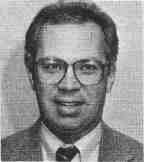
|
SMART HIGHWAYS
By WILLIAM T. SUNLEY, Engineer of Local Roads and Streets
Illinois Department of Transportation
|
The State and other governmental highway agencies in Illinois have invested billions of dollars in their
systems over recent years. Yet, after spending all that
money, there are still major jam-ups on many urban
thoroughfares. Congestion has spread to the principal
arterials and, in Illinois, is most prevalent in Cook
County and the northeastern counties surrounding Chicago. Unfortunately, we can not build ourselves out of
this congestion.
What there are plans for, though, are electronic navigation systems. Simply pat, electronic navigation
works by providing drivers with a computerized road
map showing congestion ahead and flashing suggested
alternate routes around the trouble. It is one part of a
broader area of research and development collectively
called Intelligent Vehicle Highway Systems (IVHS), or
commonly known as "smart cars/smart highways".
In early 1989 the Illinois Department of Transportation initiated a study to determine the scope, feasibility
and cost of a demonstration of an advanced route guidance system in the northwest Chicago suburbs. The
study, completed in August of 1990, was conducted by
Northwestern University, the University of Illinois at
Chicago (members of the Illinois Universities Transportation Research Consortium) and Motorola, Inc.
under the sponsorship of the Illinois Department of
Transportation.
As a result of that study, it was decided that a Dynamic Route Guidance System (DRCS) demonstration
be conducted to gather, analyze and organize data on
the current performance of a network of arterial roads.
Data collected would be continually fed to vehicles
equipped with a computer screen to help the drivers
adjust route choices, departure times, and other behaviors to improve travel times.
The study will be conducted in an area of 200-250
square miles in the northwest suburbs just north of
O'Hare Airport. The size of the area is large enough to
generate a substantial number of trips and will permit
complete tracking of a large percentage of those trips
because they begin and end within the area. The study
area was chosen because it contains a good mix of
residential, commercial and industrial land use and is a
fast growing, congested area.
From 3, 600 to 4, 900 vehicles will be equipped with
in-vehicle navigation and route guidance systems. This
number of vehicles will provide sufficient data to determine actual traffic conditions in the area. Each
equipped vehicle would transmit real time information
to a control center concerning travel time and location.
The control center would analyze this information and
transmit abnormal traffic conditions back to the
equipped vehicles. The driver could use this transmitted knowledge about traffic conditions to adjust
routes of travel.
The concept of this study is different from others in
that the equipped vehicles will be used as probes to
determine the level of congestion. In addition, the geographic area of the demonstration would be larger than
any other IVHS demonstration project; it would involve more test vehicles than any other IVHS demon-
stration; and it would be the first study ever conducted
Illinois project information provided by: Robert York, Chief of
Urban Program Planning, Office of Planning & Programming
Page 22 / Illinois Municipal Review / February 1991
using major arterials instead of a freeway system.
The demonstration will start this year and is expected to last 4 to 5 years with costs estimated to be $30
to $42 million. This cost will be shared by FHWA,
Motorola, the Universities and the State of Illinois.
When completed, the study will help determine future
utilization of Intelligent Vehicle Highway Systems in
Illinois and elsewhere.
There are obstacles to overcome. Intelligent Vehicle
Highway Systems do not come cheap. In addition, motorists might not be receptive to a computer screen
located in their cars and trucks giving them instructions.
Although the IVHS technology will take time to implement, the potential benefit of reducing congestion
may outweigh the cost. •
Illinois project information provided by: Robert York, Chief of
Urban Program Planning, Office of Planning & Programming
February 1991 / Illinois Municipal Review / Page 23